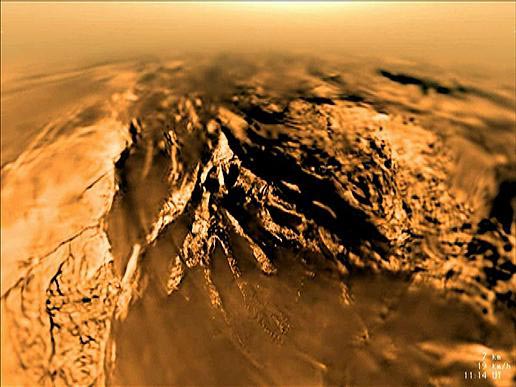Titan in Motion: New Video of Landing on Saturn's Moon

Europe's Huygens probe was quite alone when it set down on the surface of Saturn's moon Titan, but two new videos based the landing allow viewers to hitch a ride aboard the spacecraft's descent.
The videos give an up-close view of the European Space Agency's Huygens Titan touchdown on Jan. 14, 2005, with one recording offering a probe's-eye-view of the landing while the other includes more technical view.
"It was a very complicated process," said Erich Karkoschka, a senior staff scientist with the Lunar and Planetary Laboratory at the University of Arizona who integrated the Huygens images into mosaics and videos. Putting the images together "to build mosaics and make it without any seams ... that took quite a lot of time."
Painstaking production
Huygens spent about 147 minutes descending through Titan's atmosphere. During that time, the probe's NASA-funded Descent Imager/Spectral Radiometer (DISR) photographed the moon's orangish atmosphere and mottled, gullied surface from three separate angles.
Karkoschka compressed the 2.5-hour descent into the four-minute and 40-second video "View from Huygens," adding some additional flourishes on the surface to portray additional findings - such as the methane signature detected by the ESA probe. Researchers believe the warm probe helped release the gas when it touched down on the cold moon's surface.
"Knowing this area was wet in methane was quite exciting," ESA's Jean-Pierre Lebreton, Huygens project scientist and mission manager, told SPACE.com. "Huygens is really serving as the ground truth for the orbital observations."
Breaking space news, the latest updates on rocket launches, skywatching events and more!
"View from Huygens" begins with images of the Earth passing between the Saturnian system and the Sun, then zooms in on Huygens' Titan approach as the viewer follows the probe down to the shrouded moon's surface. Once firmly on Titan, the probe yields images of a frigid world dotted with pebbles of water ice.
"You get the scale from millions of kilometers to just millimeters," Karkoschka said in a telephone interview. "All those different scales in just a few minutes, to see how they fit together, I think that's what's most interesting to me."
The second video, which Karkoschka called the "Descent with Bells and Whistles," includes spacecraft telemetry such as position - illustrated by a snazzy probe animation - direction, speed and other vehicle performance. The center frame is reserved for Huygens' view of Titan, which comes in frame-by-frame as the DSIR camera gets to work. The video runs less than five minutes.
"It really shows what's happening with the descent," Lebreton said. "It's the motion of the probe, the swinging and the bouncing ... I almost see myself piloting the probe down to Titan."
Huygens' movement complicated the mosaic assembly and video production, researchers said.
"It was especially difficult because the probe was spinning a lot, much more than we predicted," Karkoschka said, adding that the motion may have been due to the parachute-lander system itself rather than Titan's winds.
A Titan retrospective
ESA's Huygens probe flew to Titan aboard the Cassini orbiter, a joint mission by NASA, ESA and the Italian Space Agency, ejecting free of its parent vehicle on Dec. 25, 2004. Cassini still circles Saturn today and is actively studying the planet and its moons.
Three weeks after deployment, Huygens streaked through Titan's atmosphere and spent 2.5 hours parachuting towards the Saturnian moon's surface, returning wind sounds and radar, as well as hundreds of images detailing the hilltops and deep gullies that appear in the new movies.
Karkoschka said Huygens compressed its data into just eight megabytes for delivery to Cassini, which then sent the information back to Earth to be extracted.
"There is really a lot of work behind the movies you have seen," Lebreton said. "And we still have a lot of work to put things together and extract all the data."
From an initial view that included about 3,861 square miles (10,000 square kilometers) to the icy pebbles of its landing site, Huygens revealed a Titan never seen before.
The probe confirmed that high above the surface - about 75 miles (120 kilometers) up - winds blow around Titan at about 270 miles per hour (434 kilometers per hour), or faster than the moon rotates, in a process called superrotation.
Some levels of the moon's atmosphere are oddly devoid of wind, while the atmosphere itself is composed primarily of nitrogen and methane, with some argon mixed in. Though researchers did not find the liquid pools of methane or other hydrocarbons they expected on Titan, Huygens images returned vistas of areas that suggested they were once coastlines, rivers or other drainage formations.
"The images showed us what Titan looks like on a small scale," Lebreton said, adding Huygens has scratched the moon's surface. "It's inviting us back."
- VIDEO: Huygens Probe's View of Titan Landing
- Saharan Sand Dunes Found on Saturn's Moon Titan
- New View of Titan: Strong Winds, Soft Ground and Lightning
- Huygens Probe Returns First Images of Titan's Surface
- Touchdown on Titan: Huygens Probe Hits its Mark

Tariq is the award-winning Editor-in-Chief of Space.com and joined the team in 2001. He covers human spaceflight, as well as skywatching and entertainment. He became Space.com's Editor-in-Chief in 2019. Before joining Space.com, Tariq was a staff reporter for The Los Angeles Times covering education and city beats in La Habra, Fullerton and Huntington Beach. He's a recipient of the 2022 Harry Kolcum Award for excellence in space reporting and the 2025 Space Pioneer Award from the National Space Society. He is an Eagle Scout and Space Camp alum with journalism degrees from the USC and NYU. You can find Tariq at Space.com and as the co-host to the This Week In Space podcast on the TWiT network. To see his latest project, you can follow Tariq on Twitter @tariqjmalik.
